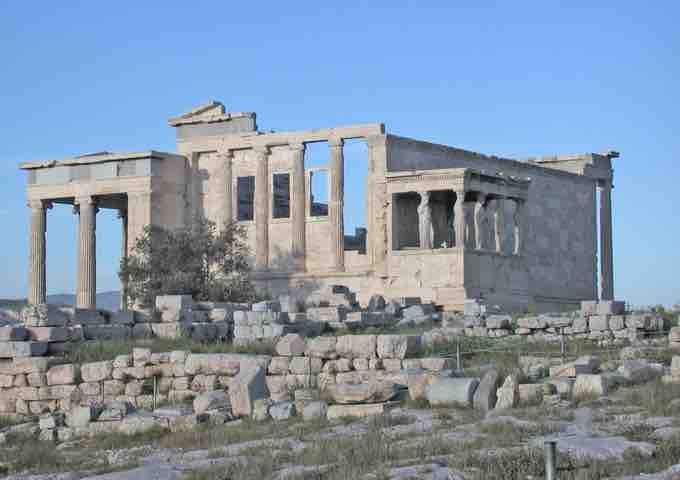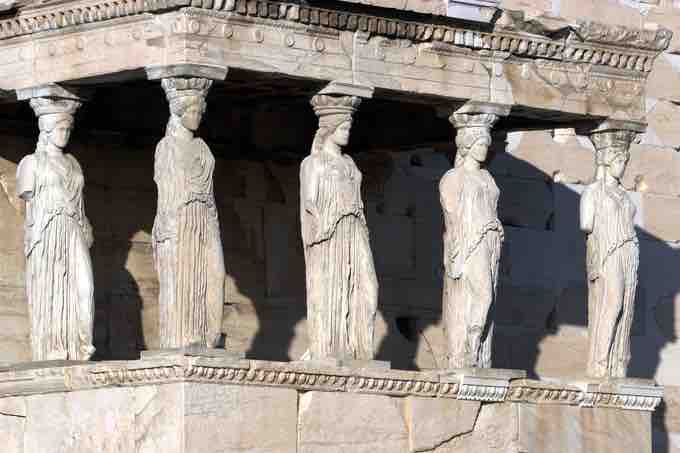Propylaia
The Propylaia is the monumental gateway to the Acropolis. It funneled all traffic to the Acropolis onto one gently sloped ramp. It was designed by the architect Mnesicles, and was begun in 437 BCE. The Propylaia created a massive screen wall that was impressive and protective as well as welcoming. It was designed to appear symmetrical, but was not. The southern wing of the Propylaia incorporated the original cyclopean walls from the Mycenaean citadel; this space was truncated but served as dining area for feasting after sacrifice. The northern wing of the Propylaia was much larger. It was a pinacoteca, where large panel paintings were hung for public viewing. Despite the structure's lack of symmetry, from its entrance it was designed to appear symmetrical; this illusion was created by a colonnade of paired columns that wrapped around the gateway. The order of the Propylaia and its columns are Doric and the decoration of is plain and simple; there are no reliefs carved into the metopes and the pediment is unadorned.

Propylaia
The Propylaia as it stands today. Acropolis, Athens, Greece. ca. 437-432 BCE.
Statue of Athena Promachos
Upon entering the Acropolis from the Propylaia, visitors were greeted by a colossal bronze statue of Athena Promachos. This statue was also designed and created by Phidas and was dedicated around 456 BCE. Accounts and a few coins of the statue allow us today to conclude the bronze statue portrayed a fearsome image of Athena striding forward, helmeted, her shield at her side and her spear raised high, ready to strike.
Erechtheion
The Erectheion was built on the site of the Hekatompedon, which was the archaic temple to Athena, and also over the megaron of the Mycenaean citadel. The odd design of the temple, built from 421 to 405 BCE by the architect Mnesicles, results from the site's topography and the temple's incorporation of numerous ancient sites. The temple housed the Palladium, the ancient olive-wood statue of Athena. It was also believed to be the site of the contest between Athena and Poseidon, and so displayed an olive tree, a salt water well, and the marks from Poseidon's trident to the faithful. Shrines to the mythical kings of Athens, Cecrops and Erechteus, who gives the temple its name, were also found within the Erechtheion. Because of its mythic significance and its religious relics, the Erechtheion was the ending site of the Panathenaic festival, when the peplos on the olive-wood statue of Athena was annually replaced with new clothing with due pomp and ritual.

Erechtheion
Erechtheion from the southwest. Acropolis, Athens, Greece. ca. 421-405 BCE.
Caryatids: The Form and the Symbol
A porch on the south side of the Erechtheion is known as the Porch of the Caryatids, or the Porch of the Maidens. Six towering sculpted women (caryatids) servesupport the entablature of the building. The women replace columns, yet look columnar themselves. Their drapery, especially over their weight-bearing leg, is long and linear, creating a parallel to the fluting on an ionic column. While they stand in similar poses, each statue has its own stance, facial features, hair, and drapery. They carry egg-and-dart capitals on their heads, much as women throughout history have carried baskets. Between their heads and this capital is a sculpted cushion, which gives the appearance of softening the load of the weight of the building.

Porch of the Erechtheion
The porch of the Erechtheion with caryatids. Acropolis, Athens, Greece. ca. 421-405 BCE.
The sculpted columnar form of the caryatids is named after the women of the town of Kayrai, a small town near and allied to Sparta. At one point during the Persian Wars the town betrayed Athens to the Persians. In retaliation, the Athenians sacked their city, killing the man and enslaving the women and children. Thus, the caryatids depicted on the Acropolis are symbolic representations of the full power of Athenian authority over Greece and the punishment of traitors.